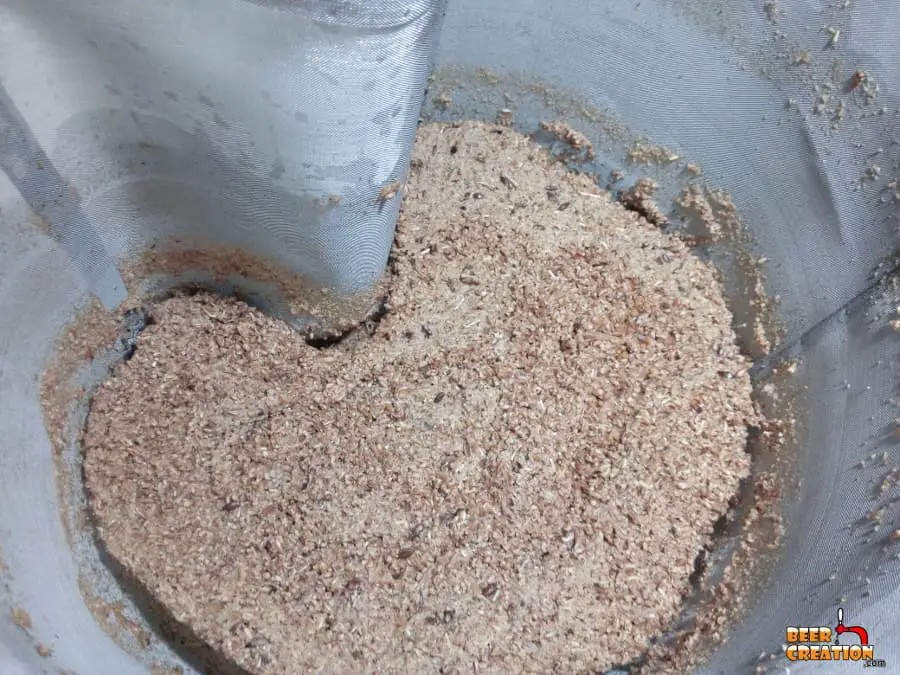Now, growing up my Dad was always a very keen gardener and grew heaps of veggies for all the family. I remember him disappearing to the bottom of the garden most evenings with all the compostable waste from the day.
This sort of got me in the mindset that we shouldn’t waste anything which can help us make something else, and so when I started brewing beer I had to ask myself what to do with all this spent grain I was producing. So, would my Dad be trotting off to the bottom of his garden with my brewing leftovers or not?
So, you can compost spent grain as well as use it in many other ways. Apart from composting, there are other ways to be eco-friendly and reuse them. You can bake with them, feed livestock, make dog treats (not with spent hops, those are toxic), grow mushrooms, donate them, and even make energy.
In fact, after doing a little bit of research, there really isn’t any excuse for dumping your spent grain in the trash. With a little bit of imagination and effort, you can put that beer-giving grain to a fantastic use and help out the environment at the same time.
While composting may not be the easiest thing to do if you do not have a lot of time and space in your yard you can always find a neighbor or a farm to take it off your hands as spent grains are full of nutrients.
Since you are probably brewing small batches other options may be more feasible and convenient for you.
So, read on below as I will go over everything you can do with your spent grain and exactly how to go about it.
Will spent grain work as a compost material?

Absolutely, it will, and probably the easiest way to use spent grain in compost bury in the ground. I know some of you more green-fingered readers might be screaming at me now, but hear me out.
For beginners, you can basically dig a small ditch in between your rows of plants or flowers and fill it up halfway with the spent grain. Then, simply cover it with dirt, and there you go.
This way, the microbes that already are in your garden can do all the work with the new materials. This is a very simplified version of composting spent grains and there are a few caveats and things to think about.
New to homebrewing? Please feel free to read my ultimate guide to brewing beer at home and where to start.
The basic principle
When looking at ways to compost you need to think about what you are composting.
Spent grain is viewed as “fresh (green matter)” just as grass clippings are. If you ever had a lot of those you know that you can’t just let them sit by themselves as they will not break down very quickly.
For this, you will need to compost them with the “hot composting” technique which involves layering the material with some “dry (brown matter)” like leaves or even straw. According to my Dad, a commonly used ratio would be about 2:1 green matter to brown matter.
In this way, your spent grain will break down nicely, and this is why in the basic trenching technique I mentioned before, you only fill it up halfway with grains.
Basic Composting equipment
If you are serious and you really want to put your spent grain to good use, then you’ll need the following basic kit (and some other tools to take it to the next level:
- Scoop Shovel
- Spade
- Pitchfork
- Aerator
- Pruning Shears
- Loppers
- Shredders and Chippers
- Watering Can
- Hose
- Screens
- Mulching Mowers
- Compost Chopper
- Compost Thermometer
- Compost bin
If you aren’t able to get down to the local hardware store, luckily you can get all these delivered to your door by Amazon!
Reasons not to compost
Disadvantages of using spent grains directly in your backyard
Smell
There are a few different smells that can occur if this is not handled properly. You can always add some brown material to all steps to help. Also by mulching the grains you can automatically avoid the ammonia and anaerobic smells altogether.
If you mulch the spent grains rather than compost:
Vinegary and fermentation smell– in the beginning, you may have these smells which come from too much sugar or wort in the grains. These also can then attract hornets.
So, to avoid this you can aim for higher brewhouse efficiency and continue to sparge with water to get out all the sugars and starches. Of course, don’t do this too much as you’ll then have overly diluted wort.
Ammonia smell– This happens later on in the process. To avoid it again, mix in brown material.
Anaerobic smell– This again occurs a bit later on in the process. To avoid anaerobic smells mix in enough dry materials. You want air to be able to enter the pile while it is drying, and you don’t want it to remain wet.
Space
To do all of these things you will need an ample amount of space. It could be possible to do in a composting bucket but depending on your diet and the other amount of waste you accumulate this could be a big portion of your space.
This also comes into play if you have cats and dogs, trying to keep them away from the waste could be hard in a small area. I know my dog Mia goes for the strangest things and would get into anything nice and stinky if I let her.
On the other hand, it could be equally hard to keep an eye on them in a very big yard. My Dad has a dedicated compost bin which is quite secure, so investing in something like that could be an option.
However, I have to admit that at the moment I can’t compost my own grains because of where I live, so is dumping them in with other organic waste an option?
Local laws – Dumping grains
Will the local authorities allow you to throw spent grains in with yard waste?
Sadly most places will no allow this without special authorization from the city. Boroughs and municipalities tend to be very strict on this.
They are very strict because there are so many people and if they allow one person to dump/ leave out something that is not on the list of approved waste others will follow suit. Smaller towns and some neighbors are very nosey and will complain as well.
So you can either just leave it out and hope they take it (which in the worst case they just leave it behind) or go and ask for permission. When asking for permission make sure to explain that grains are the same type of waste “green matter” as grass clippings.
They probably do not know this and just think that it will not break down, or they want to charge you an extra fee to make money.
So, by far the best option is to use the spent grains for some other use than composting.
What are some other uses for spent grain
If you don’t or can’t compost or mulch that is not a problem. There are a lot of other things that you can do with your spent grains.
Baking/Cooking- The leftover spent grains can be used in your cooking and baking as well. You can use both when it is wet, literally straight out of the mash tun, or when dried.
Either wet or dry, you can put it in things such as bread, crusts, soups, chilis, cookies, brownies, etc.
A lot of wet grain is not common, it is usually used in small quantities for flavor and texture. Let’s not forget that it’s the same ingredient in many everyday foods. You could also turn it into flour for baking if you really have nothing else to do!
Stock Feed– If you have animals like cows, horses, sheep, pigs, etc. or know someone that does they could possibly use it as well.
However, cows, sheep, and pigs are usually better at digesting the spent grains. Our residence actually sends all organic waste to a pig farm, and when I found this out I found a home for most of my spent grain.
This being said, the grains should also be used as quickly as possible as wet grain does spoil pretty quickly depending on different factors and you don’t want the animals to get sick. Lastly, spent grain is really only supplementary feed, and shouldn’t be the main course for the animals.
Flock Feed– Similarly to livestock chickens, ducks, geese, etc can also eat this as a supplementary feed, but in lesser amounts.
They will need to eat it that day and it can’t be left out to go bad. You can freeze small amounts of the spent wet grain if you don’t use it all at once and thaw it as needed. Some people even dry it out and mix it in with their regular bird feed.
Grow Fungi -Yes, you can grow mushrooms from your spent grain. Since there are high amounts of nitrogen you have to mix it with other substances as you would with compost but you still could grow fungi as well.
It is harder than composting and different mushrooms grow better in different substrates and conditions, so you will have to do your homework. This could be another fun hobby like homebrewing for you to experiment with.
Dog Treats– As with baking you can use your spent grain as filler for dog treats. While you can you grains, DO NOT use hops as it is very toxic to dogs and cats. You want to check for recipes that don’t use all spent grains and then make the treats with mostly barley/oats which are more digestible for our four-legged friends.
Donate/Sell- Just because you can’ use them doesn’t mean that someone else can’t. Spent grain can be a valuable resource and it is possible to even sell them in the right situation. Check with local farmers, farmer markets, or gardeners, one of these groups would likely be happy to take it off your hands or even pay for it in bulk.
Energy- I have only seen this at a brewery in Alaska but it is a great idea and others should be thinking about and adopting the idea.
At Alaskan Brewing Co. the founder and his staff created “a first-of-its-kind biomass steam boiler,” that is fueled entirely by their spent grain. Ashley Johnston of ABC estimates that “The new boiler will completely eliminate the brewery’s use of fuel oil in the grain drying process, and displace more than half of the fuel needed to create process steam for the brewing process.”
OK, you don’t have space for a compost bin, so you probably don’t have space for this but it was still a cool use for spent grain!
How do you dry spent grain for a feed?
There are a handful of ways that you can dry and preserve spent grain. It will mostly come down to accessibility and what you want to do with the grain.
- Freeze drying – Is lowering the temperature while also dehydrating the grain and this will reduce the volume of the grain without altering the composition. You can do it at home, but would need a special setup.
- Oven drying – This is the most common method with homebrewers and can take as little as a few hours. It will reduce the volume of the product while still not altering its composition. Be careful not to burn it though.
- Freezing method– Just taking the wet grain and freezing it, a method that can easily be used to produce feed.
- Thin-layer drying and Membrane filter press– More complicated methods not usually used for homebrewers.
How long can spent grain last?
This will vary on the level of water in them and the reason that you are want to use them. In my experience, in hot temperatures after a couple of days, the grain starts to whiff a bit if left unrefrigerated.
So, in a refrigerator, you should choose a course of action within at least 7-10 days, especially if you’ll be the one eating it.
If you plan to keep them for a long time I would recommend that you not only do your research but to have the proper equipment to dry and store the grains as well.
Can you compost spent hops?
Composting spent hops is similar to composting your grain, leaves, or grass. You will follow the same steps as you normally would with “brown matter”.
The same issues will arise with smells but there is one major difference. Hops can be toxic and even deadly to dogs and cats. It’s something I’m personally very careful about with my little brew dog.
Cats are not usually an issue as they spend more time indoors and are finicky eaters but still, it can harm them. Dogs will eat almost anything and some breeds are more vulnerable than other ones so be careful when composting spent hops.
You want to make sure that the area is fenced off and or not around your’s or any neighborhood animals. A communal garden may not be the best place unless it is agreed upon by all.
So, as much as it pains me to say it if you can’t be sure that your hops will break down in a safe place away from canine and feline intervention, see if you can get rid of it another, safer way.
For example, if you don’t sleep so well, then brew with your hops in a muslin bag or hops spider (see Amazon). After use, dry your hops out again and put them in another muslin bag, and shove it in your pillow. The sedative properties of the hops should still be strong enough to help you drift off naturally!
Can you brew with spent grains a second time?
As far as I’m aware, it’s not common practice to brew a completely separate batch of beer using the same grains on another day. Although you can do this with the yeast cake from one brew to another, actually doing it with the grain bill isn’t something I’ve heard on the grain vine (see what I did there..)
This being said, there is a very historic practice of getting multiple beers from the same batch of grains. You can brew with spent grains twice but it would be a very low gravity beer. The process is called parti-gyling, which means that you get multiple beers out of the same mash.
It’s actually something which brewers from as far back as we know used to produce different types of beers for different purposes. You had your beers for quenching the thirst of laborers, those for the kids, table beers, and finally the beer you drank to get utterly drunk.
Each of the batches of wort taken through the grain bed was called a gyle. It’s still something that even some pretty famous breweries do to produce different strength beers even today. Think Belgium and Germany rather than Boston and Grand Rapids.






